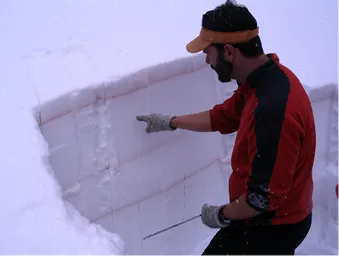By Jane Beitler
NSIDC researchers are exploring an unexpected risk to the U.S. Rocky Mountain snowpack and Western water supplies: a coating of desert dust. Their ongoing project suggests that desert dust landing on mountain snow may reduce water supplies for cities, agriculture, and industry far downstream.
Dark questions
Large dust storms in spring can blow from distant plains and deserts, settling as a pinkish or brown coating over the white snow high in the mountains, where cold temperatures normally keeps the snowpack stable and slow to melt. The Rocky Mountain region has become dustier since the 1800s, as human settlement and activity kicked up more dust, and recent periods of drought across the West brought even more dust to the Rockies' snowy heights. NSIDC scientist Tom Painter saw firsthand from his treks in the mountains that dust-covered snow seemed to melt faster. As a cryospheric scientist, he knew the importance of snow's bright, highly reflective properties in slowing its melt. Could he show that a dusty coating defeated snow's usually high albedo and sped up melt? In 2003, Painter and PhD student Jeff Deems set up observations to find out: They teamed with other Colorado researchers to collect measurements of dust-covered snow, hiking far into the high country in winter to collect samples. This small study demonstrated this to be the case: dust-covered snow, which is darker in color that clean snow, absorbs more of the sun's energy and melts faster. The simple finding that dust affects snowmelt raised many questions: Would dustier conditions affect vegetation in alpine regions? Would earlier snowmelt affect the flow of rivers, which provide water to the Western United States? And how would climate change affect the amount of dust falling on snow?
A dustier outlook
Deems has since graduated and now works at NSIDC and at the Western Water Assessment (WWA), and Painter is now at the NASA Jet Propulsion Laboratory in California, but they continue to work together on dust. In September 2010, they published a study estimating the effects of dusty conditions on snow cover in the Upper Colorado River basin, using a hydrology model of the Colorado River basin. The study showed that dust on snow robs the Colorado River of about five percent of its water each year. Now Deems and Painter are leading a broader NASA and WWA study to more thoroughly explore the connections between dust, snow, and water. With combined field observations, satellite data, and computer models, the researchers will study how dust gets blown up from the desert, travels through the atmosphere, lands on snow, and how that dust impacts snowmelt and river flow. By exploring the related systems, the researchers hope to better understand how climate change and different land management outcomes could affect the availability of water from snow. And although the study focuses on the Western U. S., the models for snowmelt and river flow could apply to mountain regions worldwide.

